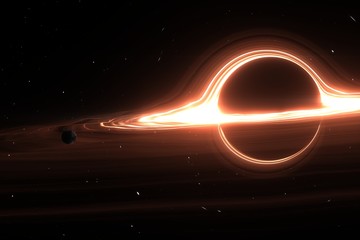Unveiling the Cosmic Riddle: How Light Bends to the Will of Black Holes!
Introduction:
Greetings, cosmic explorers! Prepare to embark on a mind-boggling journey into the heart of a celestial enigma. Picture this: light, the fastest traveler in the universe, being pulled by the invisible embrace of a black hole, a region where gravity is so strong that not even light can escape. But wait, doesn't light lack mass? How can gravity affect something weightless? Buckle up as we untangle this paradox, revealing the astonishing dance between light and black holes. Let's dive in, shall we?
Section 1: The Light-Speed Puzzle
At first glance, you might wonder why light, seemingly weightless and blazingly fast, gets caught in the gravitational web of black holes. After all, classical physics suggests that gravity is a force that acts on objects with mass, pulling them toward massive bodies. So, why should light, with no mass at all, be susceptible to gravity's clutches?
Section 2: The Mind-Bending Twist: Space-Time Curvature
The answer lies in the remarkable insight of Albert Einstein's General Theory of Relativity. Imagine the fabric of space-time, not as a static stage, but as a dynamic, flexible canvas that curves under the influence of mass. Black holes, the cosmic heavyweights, warp this canvas profoundly. Picture a bowling ball placed on a rubber sheet - it creates a dip, causing marbles (objects) to roll toward it. In a similar way, the presence of mass curves space-time, guiding objects along curved paths - even massless light.
Section 3: Gravitational Lensing: Light's Cosmic Rollercoaster
Imagine you're at an amusement park where the roller coaster (light) zips along a track (curved space-time) created by a massive attraction (black hole). As light travels near the black hole, its path curves dramatically due to the warping of space-time. This bending effect, called gravitational lensing, acts as an optical illusion, making distant objects appear in unexpected places. The stronger the black hole's gravity, the more pronounced the bending - a cosmic carnival of light!
Section 4: Event Horizon: The Point of No Return
Now, envision the event horizon, an invisible boundary beyond which the black hole's grip becomes unbreakable. As light ventures closer to this point of no return, its path becomes increasingly curved, eventually looping back on itself. This phenomenon, known as photon sphere, is like a gravitational whirlpool, capturing light in an endless spiral dance around the black hole. Even though light continues to travel, its trajectory remains trapped, giving the illusion of attraction.
Conclusion:
Behold, fellow cosmic voyagers, the captivating tale of light's cosmic tango with black holes. In the mesmerizing theater of space-time curvature, even weightless light succumbs to the alluring embrace of gravity. As Einstein's theory unveils, the fabric of the universe is far more dynamic and interconnected than we ever imagined. So, next time you gaze at the starry expanse, remember the cosmic riddle - how light's journey through space-time bends and weaves to the whims of celestial behemoths, leaving us spellbound by the grand mysteries of our universe.
Intrigued? Keep exploring the cosmic wonders and uncover more celestial secrets that boggle the mind and stir the imagination!





Comments